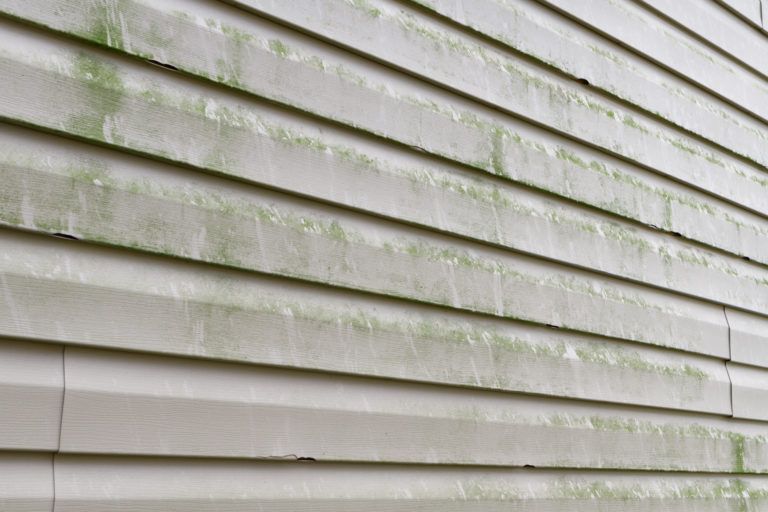
Quick Tips
- Cover sources of electricity.
- Prepare your work space.
- Gather your siding-cleaning supplies.
- Take a cursory look around.
- Make your siding cleaning solution and start scrubbing.
- Rinse during and after cleaning siding.
Unless you’re trying to give the impression of being the poorest P.O.S. on the block so would-be burglars might go next door to Douchebag Bob’s place and steal his crap instead of yours, you are eventually going to need to know how to clean siding. Aside from the fact that siding cleaning helps you to protect perhaps your largest investment—your house—it’s also likely that if you live in a neighborhood, the other members of the community will expect you to have clean siding, in order to help keep property values and appearances up.
Luckily for you, washing siding is usually a pretty easy task. This is especially true of washing vinyl siding. While vinyl siding isn’t actually maintenance-free like its producers always claim, it’s as close as it gets. This is why it’s so incredibly popular; it looks nice, and the uncomplicated process of cleaning vinyl siding is really all you ever have to do to it. Incidentally, the best way to clean vinyl siding also happens to be the best way to clean siding of pretty much any type, including aluminum siding, steel siding and cedar siding. All siding, over time, starts to accumulate a layer of dirt, sap, dust, pollen, oxidation, mold and mildew. It’s generally recommended that you wash vinyl siding (or any other type) at least once, preferably twice, a year. In the section directly below, I will give you step-by-step directions for the best method not just to clean vinyl siding, but to clean siding of any type. If you look all the way to the bottom, you’ll find advice on pressure washing siding. The best advice I can give you before you start washing siding is to not allow yourself to become overwhelmed by the scope of the job. Give yourself a couple days to clean siding, relax, and just keep plugging away.
Steps to Cleaning House Siding
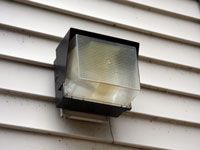 Cover sources of electricity. Whether you’re learning how to clean vinyl siding or any other house siding, this is extremely important. First, find your breaker or fuse box and turn off the power to any and all of the outside light fixtures and outlets. Next, for a little added security, cover every one of those fixtures and outlets with plastic sheets or bags and use duct tape to affix the plastic to the siding. Also—I know it seems like a no-brainer—make sure all of the doors and windows are shut tight before you start to wash siding.
Cover sources of electricity. Whether you’re learning how to clean vinyl siding or any other house siding, this is extremely important. First, find your breaker or fuse box and turn off the power to any and all of the outside light fixtures and outlets. Next, for a little added security, cover every one of those fixtures and outlets with plastic sheets or bags and use duct tape to affix the plastic to the siding. Also—I know it seems like a no-brainer—make sure all of the doors and windows are shut tight before you start to wash siding.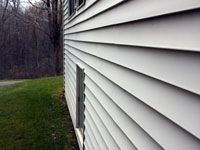 Prepare your work space. When you start to wash siding, the last thing you want to be doing is running into, tripping over, and barking your shins against what will seem to be every item you have ever owned. To avoid this problem, after you get done covering the electric bits, walk around the house and move everything that could even potentially be in your way. This will include kids’ toys, sticks and branches, yard furniture, rain spouts, decorations, grills, potted plants, etc. Speaking of plants, if you have some that can’t be moved, like shrubs and flowers, cover them up to avoid damaging them before you start cleaning siding above them.
Prepare your work space. When you start to wash siding, the last thing you want to be doing is running into, tripping over, and barking your shins against what will seem to be every item you have ever owned. To avoid this problem, after you get done covering the electric bits, walk around the house and move everything that could even potentially be in your way. This will include kids’ toys, sticks and branches, yard furniture, rain spouts, decorations, grills, potted plants, etc. Speaking of plants, if you have some that can’t be moved, like shrubs and flowers, cover them up to avoid damaging them before you start cleaning siding above them.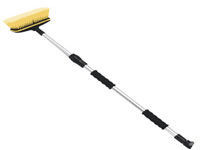 Gather your siding-cleaning supplies. This is a big job, so preparation is key. Anything you can do to make the job go faster once you’ve gotten started, like gathering everything you’re gonna need beforehand, will make your job easier. Happily, there isn’t a whole lot needed for vinyl siding cleaning or any other type of siding cleaning. First of all, dress crappy; you’re gonna get wet and dirty. Next, get a five gallon bucket, some dish soap, some oxygen bleach, some rags or a sponge, a long-handled, soft-headed brush (either a telescoping one from the hardware store, made especially for cleaning siding, or the ones they sell for washing cars), a ladder and some goggles.
Gather your siding-cleaning supplies. This is a big job, so preparation is key. Anything you can do to make the job go faster once you’ve gotten started, like gathering everything you’re gonna need beforehand, will make your job easier. Happily, there isn’t a whole lot needed for vinyl siding cleaning or any other type of siding cleaning. First of all, dress crappy; you’re gonna get wet and dirty. Next, get a five gallon bucket, some dish soap, some oxygen bleach, some rags or a sponge, a long-handled, soft-headed brush (either a telescoping one from the hardware store, made especially for cleaning siding, or the ones they sell for washing cars), a ladder and some goggles.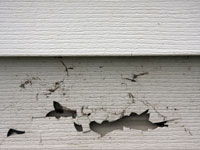 Take a cursory look around. This is where things start getting dirty. Look first for broken, cracked, or damaged siding panels and replace them. Look also for patches of mold and mildew. If you find them, clean those areas first with a solution of oxygen bleach and water (following package instructions). If you’re cleaning vinyl siding mold or vinyl siding mildew, it will come off pretty easily. If, however, the mold and mildew are on pretty much any other type of siding, it’s gonna take a little more elbow grease, and maybe a hand-held scrub brush.
Take a cursory look around. This is where things start getting dirty. Look first for broken, cracked, or damaged siding panels and replace them. Look also for patches of mold and mildew. If you find them, clean those areas first with a solution of oxygen bleach and water (following package instructions). If you’re cleaning vinyl siding mold or vinyl siding mildew, it will come off pretty easily. If, however, the mold and mildew are on pretty much any other type of siding, it’s gonna take a little more elbow grease, and maybe a hand-held scrub brush.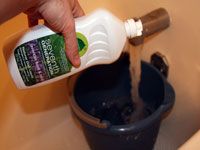 Make your siding cleaning solution and start scrubbing. Put your cool goggles on, then fill your five-gallon bucket about half way up with warm water and squirt in a few tablespoons of dish soap. Now, grab your sponge and pick a starting place. It’s best to clean siding in sections about five feet across. Start at the bottom (trust me) and work your way up. This way you will be able to avoid the streaking caused by the running of siding-cleaning solution over dirty siding. It can be very difficult to match the surrounding siding (even with cleaning) to those streaks where the cleaning solution sat for awhile. Once you get to siding that you can’t reach with your sponge, get the ladder and/or use your long-handled brush.
Make your siding cleaning solution and start scrubbing. Put your cool goggles on, then fill your five-gallon bucket about half way up with warm water and squirt in a few tablespoons of dish soap. Now, grab your sponge and pick a starting place. It’s best to clean siding in sections about five feet across. Start at the bottom (trust me) and work your way up. This way you will be able to avoid the streaking caused by the running of siding-cleaning solution over dirty siding. It can be very difficult to match the surrounding siding (even with cleaning) to those streaks where the cleaning solution sat for awhile. Once you get to siding that you can’t reach with your sponge, get the ladder and/or use your long-handled brush.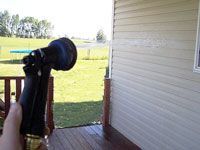 Rinse during and after cleaning siding. When cleaning siding, it is very important to rinse as you go. I say this for several reasons. First, you want to get the dirt and grime off before it has time to dry on again. Second, no matter what you used for a cleaner—whether you went with my dish soap solution or followed Satan’s advice and used bleach or TSP—it can leave your siding spotty and dingy-looking if it dries. So every time you finish cleaning a section of siding, immediately rinse it with your garden hose. Make certain to rinse the soap and dirt all the way to the ground every single time. So there, you now have all the knowledge you will need for cleaning siding. Continue scrubbing and rinsing one section at a time until you’re done.
Rinse during and after cleaning siding. When cleaning siding, it is very important to rinse as you go. I say this for several reasons. First, you want to get the dirt and grime off before it has time to dry on again. Second, no matter what you used for a cleaner—whether you went with my dish soap solution or followed Satan’s advice and used bleach or TSP—it can leave your siding spotty and dingy-looking if it dries. So every time you finish cleaning a section of siding, immediately rinse it with your garden hose. Make certain to rinse the soap and dirt all the way to the ground every single time. So there, you now have all the knowledge you will need for cleaning siding. Continue scrubbing and rinsing one section at a time until you’re done.
Power Washing Siding
I want to tell you straight up that I think it’s a poor idea to pressure wash siding. There are simply too many things that can go wrong. For instance, since house siding is designed to direct water flow downward, it’s very easy, especially if you’re pointing the nozzle of the power washer up, to force water behind your siding. Once there, it can rot the wood underneath and encourage the growth of mold and mildew. Aside from that, it’s easy to dent, crack or otherwise damage your siding with a high-pressure water. Never use a pressure washer for cleaning brick siding, wood siding, or stucco siding. If you must use a pressure washer, use it only for vinyl, steel, and aluminum siding cleaning. Anyway, if you feel it’s worth the risk to power wash siding, here are a few tips:
- Don’t pressure wash siding with jets of water stronger than 1200-1500 psi.
- Fill your power washer with dish soap (Seventh Generation), if it is approved by the manufacturer, and water. Otherwise, use straight water.
- Stand at least three feet back from the siding when spraying it.
- Never spray at an upward angle. This is tricky, but possible.
- Attach a 25º nozzle to the pressure washer and hold it at 45º to your body.
- Clean in sections of five feet across. Due to the faster speed of this method, feel free to start at the top and work your way down.
- Spray away from doors and windows.
- Promptly rinse each section after power washing.
- Pressure washing siding is much faster than the bucket method. However, there is considerably more risk involved, with the potential of it ultimately costing you lots and lots and lots of money.
Natural Siding Cleaning Solutions
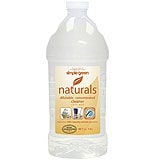 Simple Green Naturals Dilutable Concentrated Cleaner is a fantastic all-natural and biodegradable cleaner that would work very well for cleaning siding. To keep things extra green, use this cleaner with the bucket method to avoid wasting the gas or electricity it would take to run a pressure cleaner.
Simple Green Naturals Dilutable Concentrated Cleaner is a fantastic all-natural and biodegradable cleaner that would work very well for cleaning siding. To keep things extra green, use this cleaner with the bucket method to avoid wasting the gas or electricity it would take to run a pressure cleaner.
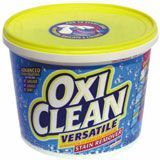 OxiClean is just one of many different brands of oxygen bleach cleaners. Oxygen bleach, aside from being great at cleaning siding covered in mold or mildew, is perfectly safe for you and the environment. It’s actually nothing more than a souped-up relative of hydrogen peroxide in powdered form. You can order a tub of OxiClean from Amazon…though we’ll always miss Billy Mays shouting at us.
OxiClean is just one of many different brands of oxygen bleach cleaners. Oxygen bleach, aside from being great at cleaning siding covered in mold or mildew, is perfectly safe for you and the environment. It’s actually nothing more than a souped-up relative of hydrogen peroxide in powdered form. You can order a tub of OxiClean from Amazon…though we’ll always miss Billy Mays shouting at us.
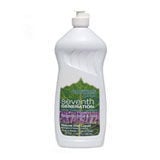 Seventh Generation Dish Soap is a fantastic choice when you’re looking to make an organic siding-cleaning solution. All of Seventh Generation’s products are natural, biodegradable, and hard-working. Head to their website to check out their array of cleaning products.
Seventh Generation Dish Soap is a fantastic choice when you’re looking to make an organic siding-cleaning solution. All of Seventh Generation’s products are natural, biodegradable, and hard-working. Head to their website to check out their array of cleaning products.